
After a Resilient Jobs Report, Is It Earnings’ Turn?
With 254,000 newly created jobs in September, the U.S. economy has once again demonstrated its strength. In addition, upward revisions to the previous two months’ numbers defied the trend of declining hiring.
Meanwhile, in other parts of the world, China largely remained closed after implementing its largest-ever stimulus. Japan welcomed a new prime minister, with a new government on the horizon. In Europe, alongside easing inflation, signs of weaker GDP growth have surfaced.
Looking ahead, U.S. inflation data and corporate earnings will be in the spotlight, but a variety of other economic reports are also scheduled for the week. Key data releases include:
- Monday: Germany’s industrial output for August, the UK’s Halifax House Price Index for September, and the Eurozone’s Sentix index for October.
- Tuesday: Japan’s current account balance for August, Australia’s business confidence and current conditions indicators for September, Germany’s industrial output for August, Canada’s trade data, and the Reserve Bank of Australia’s September meeting minutes.
- Wednesday: Australia’s consumer confidence for October and the Reserve Bank of New Zealand’s interest rate decision.
- Thursday: The U.S. CPI for September, along with the weekly U.S. initial jobless claims figure.
- Friday: Germany’s final HICP (Harmonized Index of Consumer Prices) for September, the UK’s GDP and manufacturing output for August, the U.S. Producer Price Index (PPI) for September, and Canada’s building permits and employment data. The University of Michigan’s preliminary consumer sentiment index for October will also be released.
USA Economic and Market Outlook
Contrary to initial expectations, the third quarter ended on a positive note. Stocks continued to print record highs, and despite some recent corrections, the S&P 500 closed the quarter with a gain of over 3.2%. The labor market showed similar strength. Based on last Friday’s Non-Farm Payroll (NFP) report, which saw 254,000 new jobs created, job growth averaged 186,000 during the third quarter. This was a noticeable decrease from the first quarter’s average growth of 267,000 but an improvement over the second quarter’s 147,000 average.
The overall unemployment rate unexpectedly ticked down by a tenth of a percentage point to 4.1%. Breaking down the numbers, sectors like leisure and hospitality, healthcare, and government posted strong gains in September, accounting for 71% of the month’s job growth, despite making up only about 40% of total employment.
In addition to the economic data, there were numerous speeches from Federal Reserve members. Most Federal Open Market Committee (FOMC) participants signaled more cautious decision-making ahead, which the financial markets interpreted as hawkish. This was reflected in the market reaction, especially in the strengthening of the U.S. dollar and rising bond yields. If this trend continues, the dollar may find additional support in the coming weeks as the market adjusts to these signals.
A less-discussed but important factor is the strike at East Coast ports, which could weigh on the U.S. macroeconomic outlook. A temporary deal was reached last Thursday, easing market concerns for now. However, if the deal falls apart, it could lead to further economic disruptions, particularly as the U.S. enters election season. With neither Donald Trump nor Kamala Harris holding a clear lead, especially in key swing states, the stage is set for potential October surprises that could sway both the markets and the election.
As we look ahead to this week, it’s important to note that the third-quarter earnings season kicks off, which will undoubtedly capture the attention of investors and market participants. Among the key earnings reports to watch are Delta Air Lines (DAL), JPMorgan (JPM), and Wells Fargo & Co. (WFC).
On the economic calendar, the U.S. Consumer Price Index (CPI) and Producer Price Index (PPI) reports, due Thursday and Friday, will be the focus. These reports are expected to show signs of weakening inflation. In August, the headline CPI fell to 2.5%, down from 2.9% in July, thanks to deflation in the goods sector and softer food and energy prices. However, the Core CPI remained flat at 3.2%, driven by a 0.5% increase in housing inflation, the second-highest reading this year.
For September, with energy prices remaining relatively low until their recent rebound and little change in housing costs, CPI and Core CPI are expected to increase by just 0.1% and 0.2%, respectively. These slight increases would bring the annual CPI to 2.3% and Core CPI to 3.1%, aligning with pre-pandemic levels seen in February 2020.
Given the resilience in the labor market and the expected inflation data, a slight downward trend in the markets could be anticipated this week, making a more hawkish Federal Reserve stance seem logical. From a technical perspective, the Nasdaq is trading around the critical level of 20,000. Holding this key pivot could support the bulls, but it seems less likely given the circumstances. With prices rising, On-Balance Volume (OBV) is showing lower highs, and the Relative Strength Index (RSI) isn’t offering strong support. A drop below 20,000 would put the next support level at 19,600.
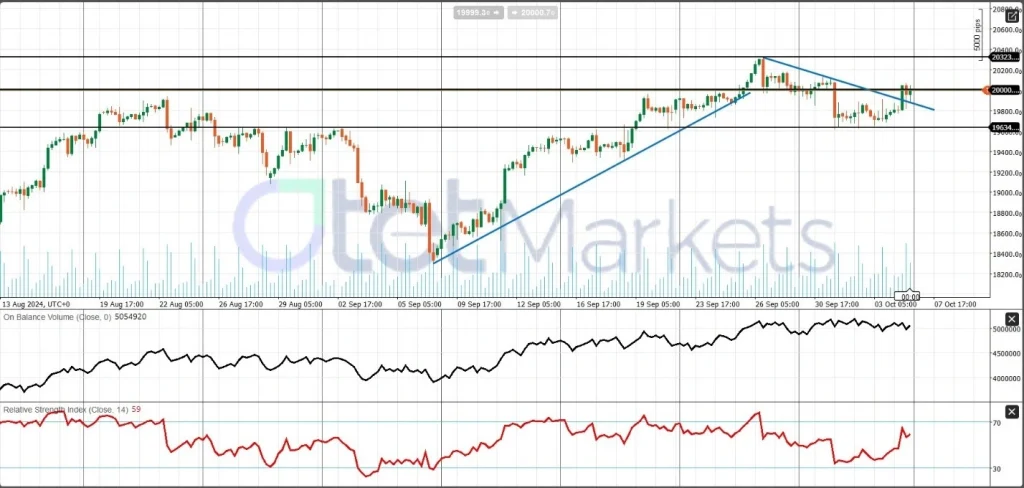
In the currency market, the U.S. dollar is gaining strength due to ongoing geopolitical tensions and heightened global risks. Hawkish tones from Federal Reserve speakers are also contributing to this bullish sentiment. Additionally, the Fed meeting minutes, due on Wednesday, are expected to reveal more divisions among policymakers, which could further support the dollar. Technically, the U.S. Dollar Index (DXY) is in a clear uptrend, with a trading range of 101.2 to 101.80 expected before the next significant move, potentially triggered by the Fed minutes release on Wednesday.
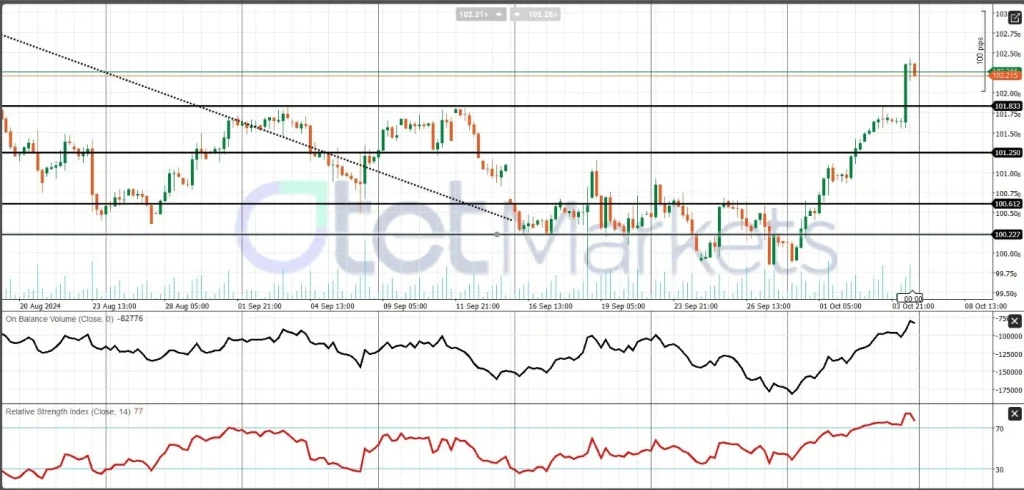
Japan and Its New Prime Minister: Economic Outlook
Last week wasn’t packed with economic data for Japanese stock markets, but the new Prime Minister and his comments on interest rates heavily influenced market trends. The Japanese yen was the biggest loser of the week, especially against the U.S. dollar, euro, and British pound. Against the U.S. dollar, the yen weakened by 4.4%, with most of the decline occurring in the latter half of the week.
On Wednesday, Japan’s newly elected Prime Minister, Ishida, stated that the Japanese economy isn’t ready for another rate hike from the Bank of Japan (BoJ). On the same day, BoJ Governor Kazuo Ueda echoed this sentiment, suggesting a more cautious approach to future rate increases, aligning with PM Ishida’s view.
In 2024, the BoJ has focused heavily on the labor market and wages. In the week ahead, the Labor Cash Earnings report will be released. Consensus forecasts suggest that annual labor cash earnings growth will slow to 3.0%, which, although lower, remains historically elevated.
If wage growth meets these expectations, it would support Governor Ueda’s and Prime Minister Ishida’s stance that there is no rush to increase interest rates. This implies that the BoJ will likely hold rates steady at 0.25%, following two hikes earlier this year, with the next potential hike postponed until 2025.
It’s also worth noting the dual nature of the yen as both a safe-haven currency and a national currency. If market uncertainties rise in the coming week, we may see the yen receive some support.
Technical Outlook: USD/JPY
From a technical standpoint, the USD/JPY pair remains bullish, with 150 serving as the next resistance level and target. The key pivot point is 147; if the price reverses below this level, it could open the door to 145. Otherwise, bulls are likely to maintain control of the direction.
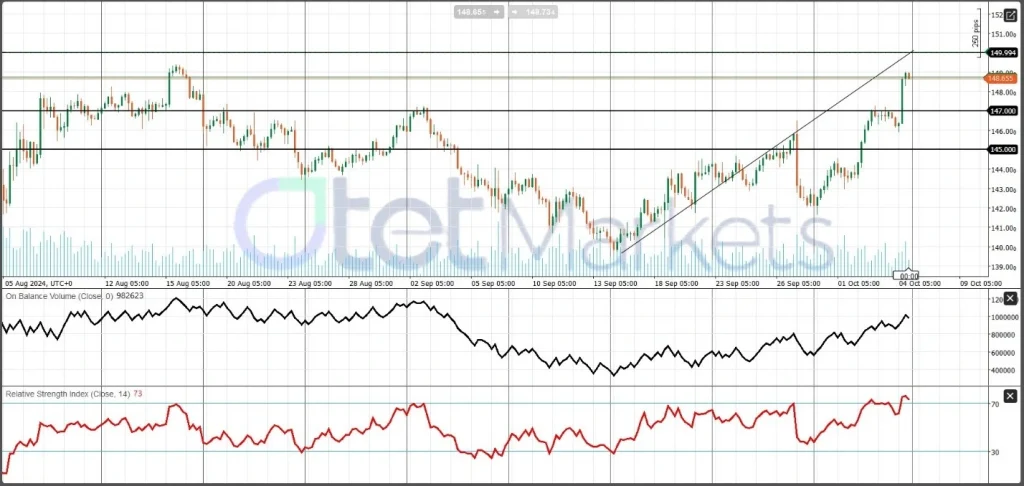
Gold: High Selloff Risk or Defensive Investment?
After a 34% gain so far this year, many believe gold faces a high selloff risk. Gold has been in an overbought territory for some time, and the buying power of gold-future speculators may be exhausted. Combined with October’s usual seasonal pullback, the recovery of the U.S. dollar, and less dovish expectations from the Fed regarding rate cuts, gold may be at risk of a significant correction.
However, the uncertainties surrounding the market, including the U.S. election and ongoing geopolitical tensions, are keeping investors cautious. With no clear frontrunner in the U.S. election, many professionals are recommending defensive investment strategies to safeguard portfolios—making gold a key safe-haven asset.
In the event of a recession, which could be triggered by further geopolitical conflicts, particularly in the Middle East, gold would likely see increased demand as a safe-haven investment.
Fundamentally, while gold remains in an overbought zone with correction risks, global economic and geopolitical conditions could limit the downside, holding bears back from taking control.
Technical Outlook: XAU/USD
From a technical perspective, $2,640 serves as the first support level; falling below this could push the market toward the key psychological level of $2,400. The key pivot sits at $2,580, and as long as XAU/USD trades above this level, any correction could reverse.
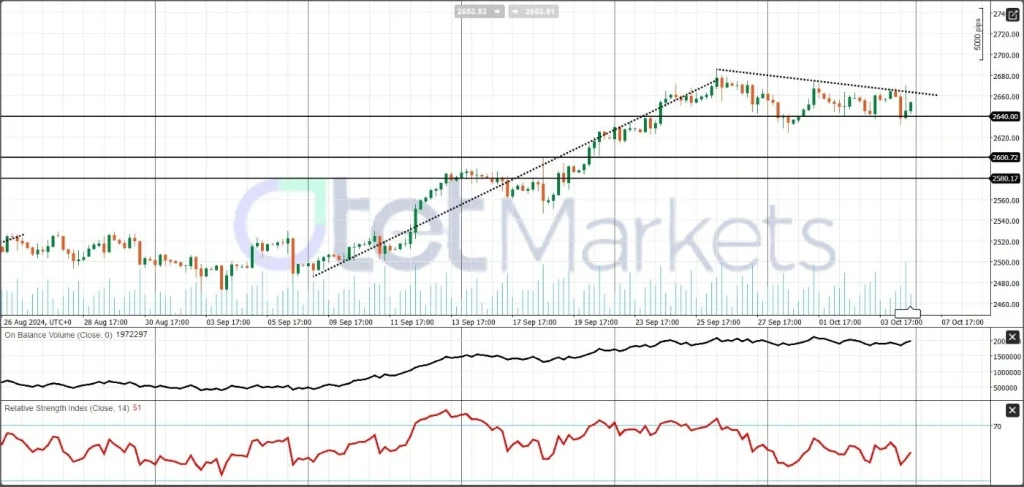
WTI: Driven by Geopolitical Tensions More than Fundamentals?
Currently, the oil market is focused almost entirely on geopolitical developments in the Middle East, rather than traditional factors like economic data or supply-demand dynamics.
The ongoing conflict between Israel and Hamas in Gaza has rapidly expanded to Lebanon, involving Hezbollah, with Iran’s backing. Recent escalations, including Hezbollah’s leader being killed and Iran’s direct missile attack on Israel, have raised concerns about a broader regional conflict. This time, Western countries have publicly supported Israel’s right to respond, signaling stronger international involvement.
The fears are intensifying as Israel continues its strikes on Lebanon, and there’s now apprehension that Israel could target Iran’s oil infrastructure in retaliation. If this happens, Iran might respond with attacks on other oil exporters in the region—similar to its 2019 assault on Saudi Arabia—or attempt to block the Strait of Hormuz, a critical passage for around 20% of the world’s daily oil supply.
However, price gains have been somewhat limited. U.S. crude inventories have increased, and OPEC has reassured markets that it has enough spare capacity to offset any potential loss of Iranian supply, should the conflict escalate.
Technical Outlook: WTI
On the technical side, On-Balance Volume (OBV) is printing lower highs despite rising prices, while the RSI is declining—both indicating a potential short-term price correction. The $72 mark is the first support level, which could be tested if tensions do not escalate significantly. However, if the conflict deepens, much higher prices could be in sight, depending on how the situation unfolds.
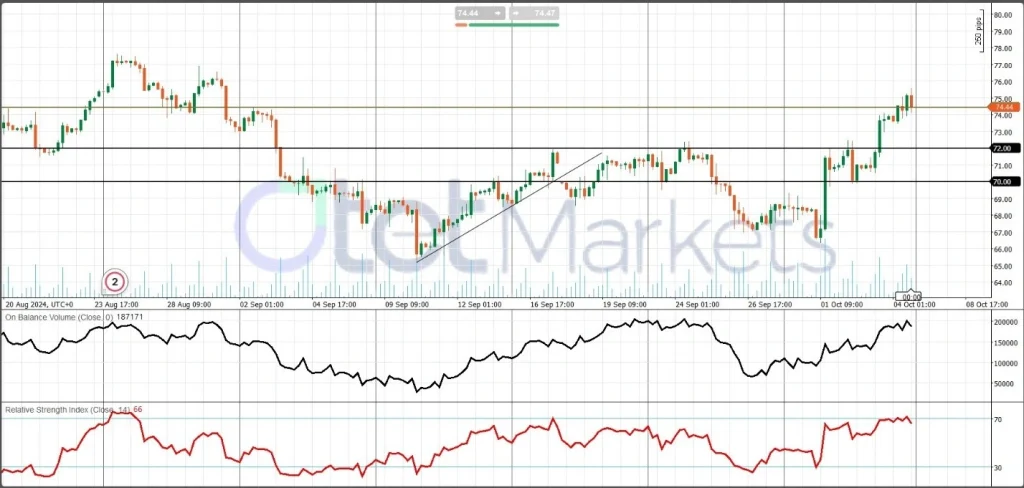
Bitcoin Between Economic Data and Geopolitical Tensions
Stronger-than-expected U.S. labor market data has given Bitcoin a boost, reflecting its behavior more like a tech stock than “digital gold.” This trend highlights Bitcoin’s evolving role in the market, as investors tend to favor traditional safe-havens like gold and the U.S. dollar during times of geopolitical tension rather than turning to Bitcoin.
After an impressive rally that took Bitcoin from an average of $53,700 to $66,000 in early September, a recent correction saw Bitcoin find solid support around the $60,000 pivot. Despite concerns over Israel’s expected response to Iran’s recent attack, which is weighing on market sentiment, Bitcoin has managed to hold its ground.
Technical Outlook: Bitcoin
From a technical standpoint, the selling pressure in Bitcoin appears to be easing. The recovery from $60,000 has solidified this level as strong support. As long as Bitcoin remains above this key threshold, bulls are likely to maintain control of the market.
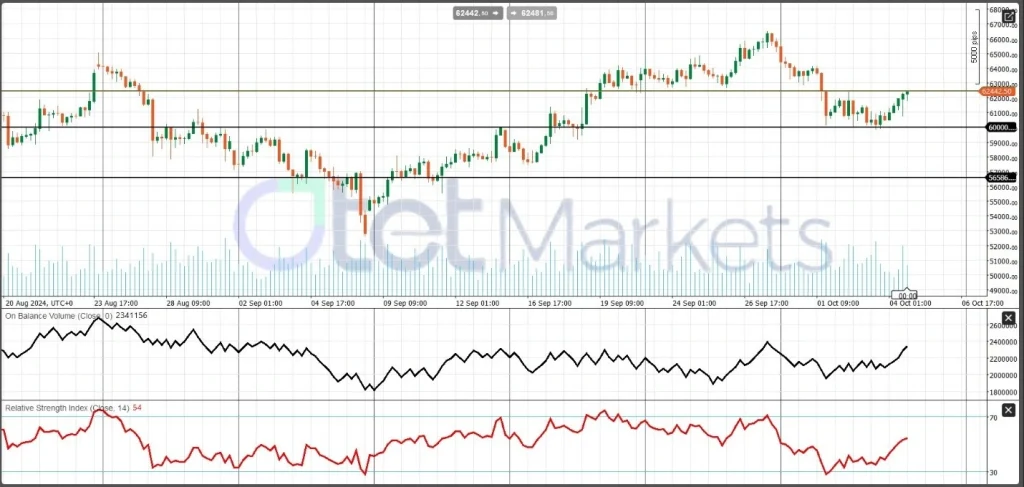
Share
Hot topics

What Is Fibonacci in Forex Trading?
If you’ve spent any time researching charts or trading tactics, you’ve most likely come across the term Fibonacci. At first glance, it may appear mysterious or frighteningly mathematical. But once...
Read more




Submit comment
Your email address will not be published. Required fields are marked *